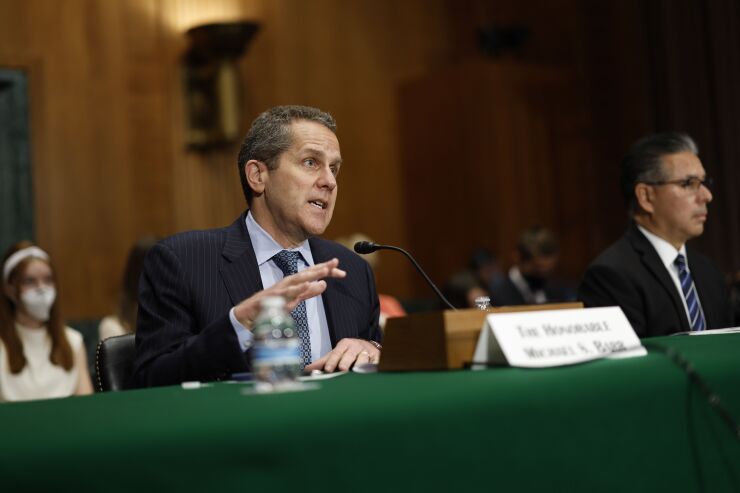Michael Barr, the Biden administration’s pick to serve as the Federal Reserve’s top regulator, said during his Senate confirmation hearing that he wants to rethink the Fed’s various capital requirements “as a whole, rather than piece by piece.”
Barr, who is expected to clear a Senate floor vote this summer to become the Fed’s next vice chair for supervision, struck a chord with that sentiment, particularly with Karen Petrou, managing partner at Federal Financial Analytics.

“After Michael said that, I thought this was just too important an idea at a moment that really could be pivotal,” Petrou said. “We need to bring attention to it and then try to help move it along, because if the U.S. just goes back to a rule-by-rule, piece-by-piece, bits-and-pieces capital regulation, we'll never get a coherent system without counterproductive impact.”
In a
The paper, released Wednesday, describes the current regulatory framework as too vast, complex and restrictive for large banks while simultaneously being focused on the overall capital requirements at the expense of safeguarding against specific risks.
“The rules for larger U.S. banks are even more of a morass than the global standards on which they are modeled, affording opportunities for regulatory arbitrage, creating pockets of unanticipated risk and contributing to the redesign of American finance into a sector that does far more for financiers than the real economy,” she wrote. “A holistic-capital construct is thus urgently needed.”
After garnering the support of five Republicans on the Senate Banking Committee along with the panel’s 12 Democrats in
He will be tasked with balancing the
Federal Financial Analytics is not the only organization hoping to capitalize on this looming sea change to influence the Fed’s thinking on regulatory and supervision. Advocates for both banks and consumers alike
Petrou said the stress test, which is used to determine the stress capital buffer that the largest banks are required to hold for the year ahead, is just one of several moving pieces in the current capital framework. She hopes Barr and the Fed’s regulatory and supervision staff will revisit it along with various other requirements to see how they might be better aligned.
“It's an important opportunity, especially if somebody figures out how to make the SCB make sense with the [global systemically important bank] surcharge and the [total loss-absorbing capacity] capital add-ons,” she said. “These are all siloed requirements, each aimed at ultimately the same goal, which is sound banks that fail without moral hazard or systemic impact.”
Historically, Petrou notes, the Fed and other regulators have taken a piecemeal approach to setting capital requirement standards. This approach has created a set of rules that can be counterproductive while offering little guarantee of being able to protect financial stability.
Existing capital requirements do not necessarily protect banks against exogenous shocks, she said. Instead, they can lead to a variety of unintended consequences, such as the dysfunction in the Treasuries market and the offloading of certain lending activity to unsupervised nonbanks.
“We're arguing for using capital where capital is useful, and there the capital standard should be quantitative, as straightforward as possible and as stringent as needed,” Petrou said. “The paper argues against the current framework, in which capital is often a proxy for effective supervision and powerful enforcement.”
Tweaking each requirement individually creates new blind spots and opens opportunities for regulatory arbitrage, Petrou said. Instead, she favors pairing a simplified capital framework with enhanced supervision methods, ones that can identify and address emerging risks.
“The goal of holistic capital is not to reduce regulatory capital,” she said. “It is to better align capital with the risk for which capital is effective, and to use supervision and enforcement in a really meaningful way to capture the other risks.”






